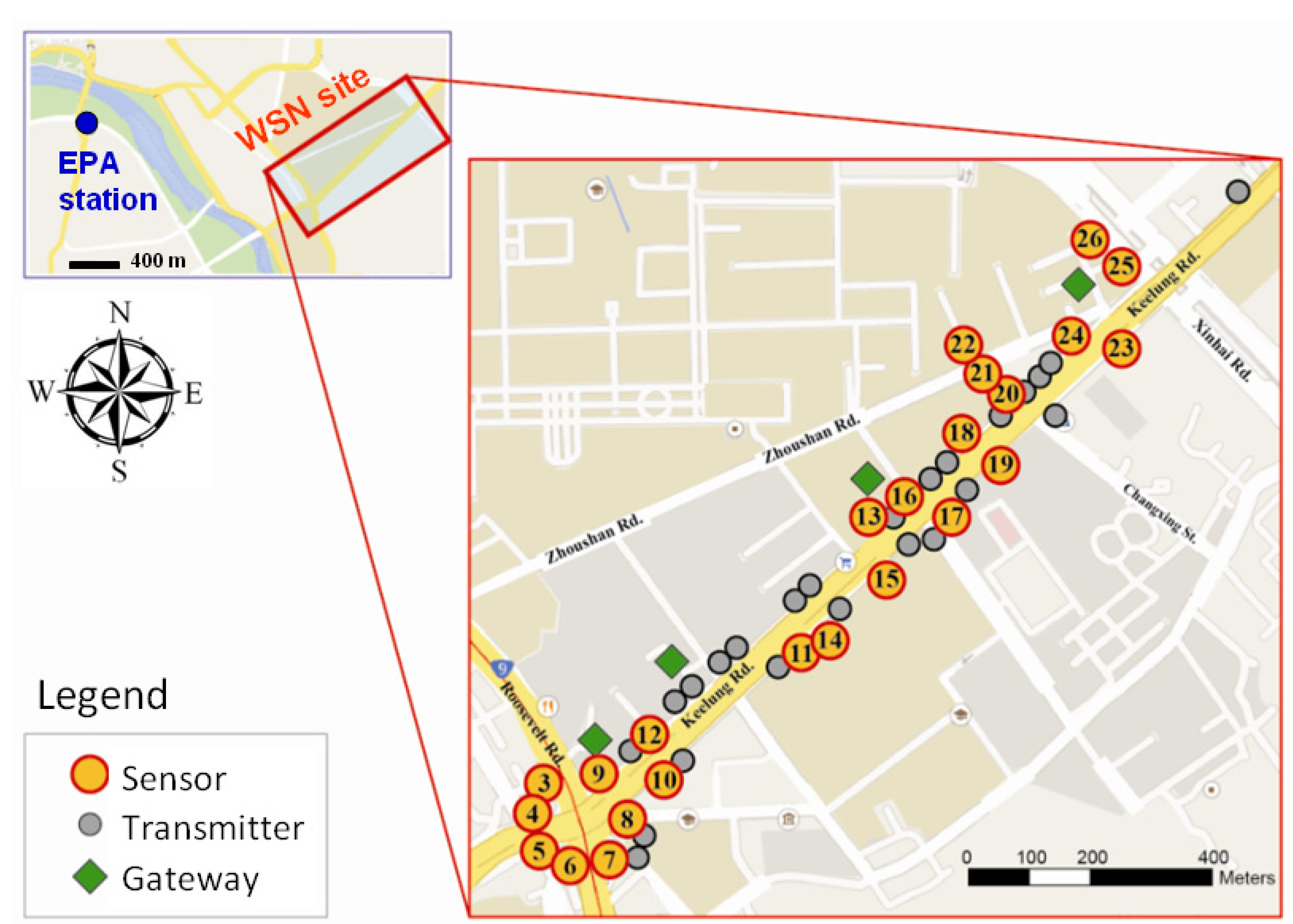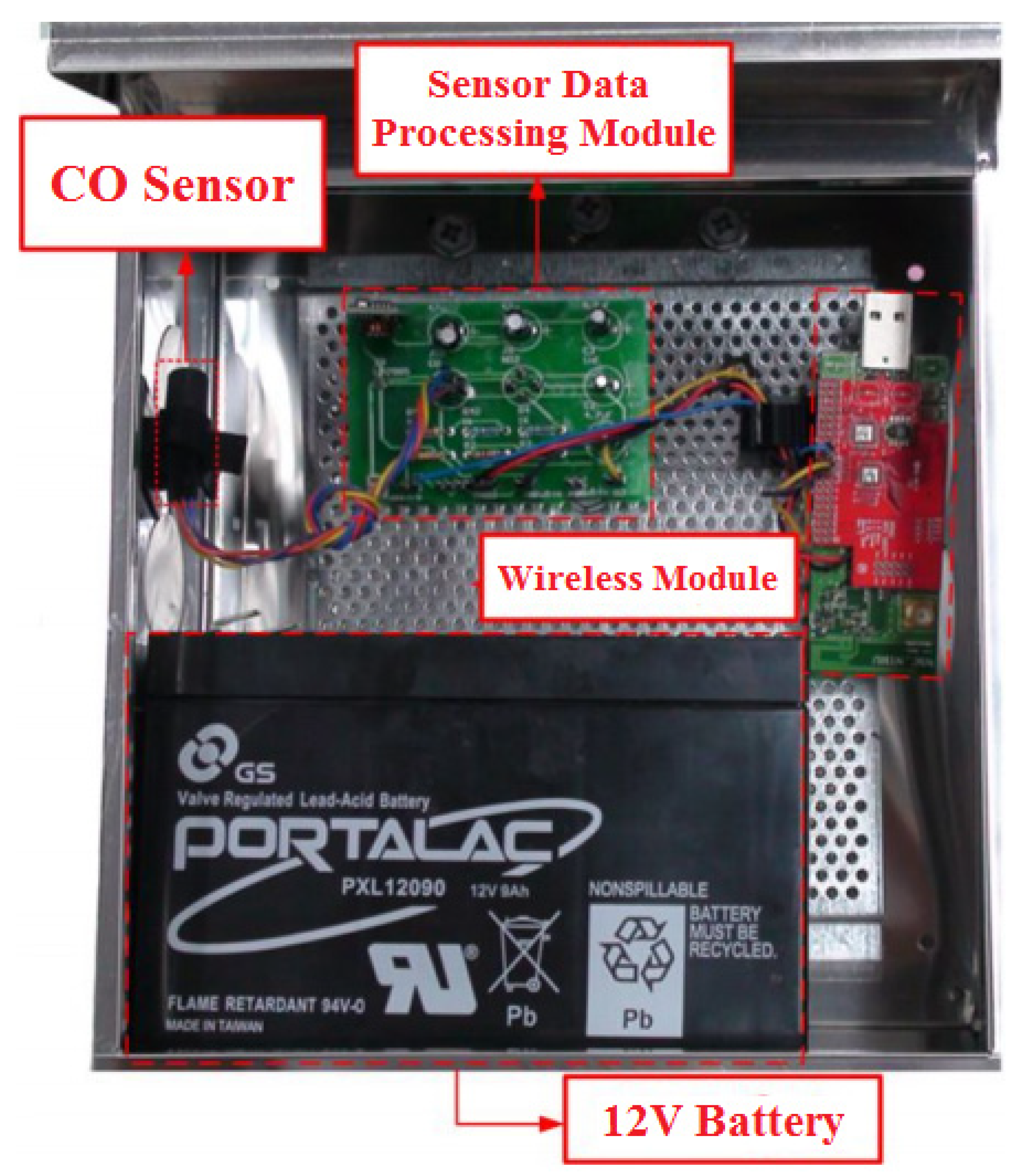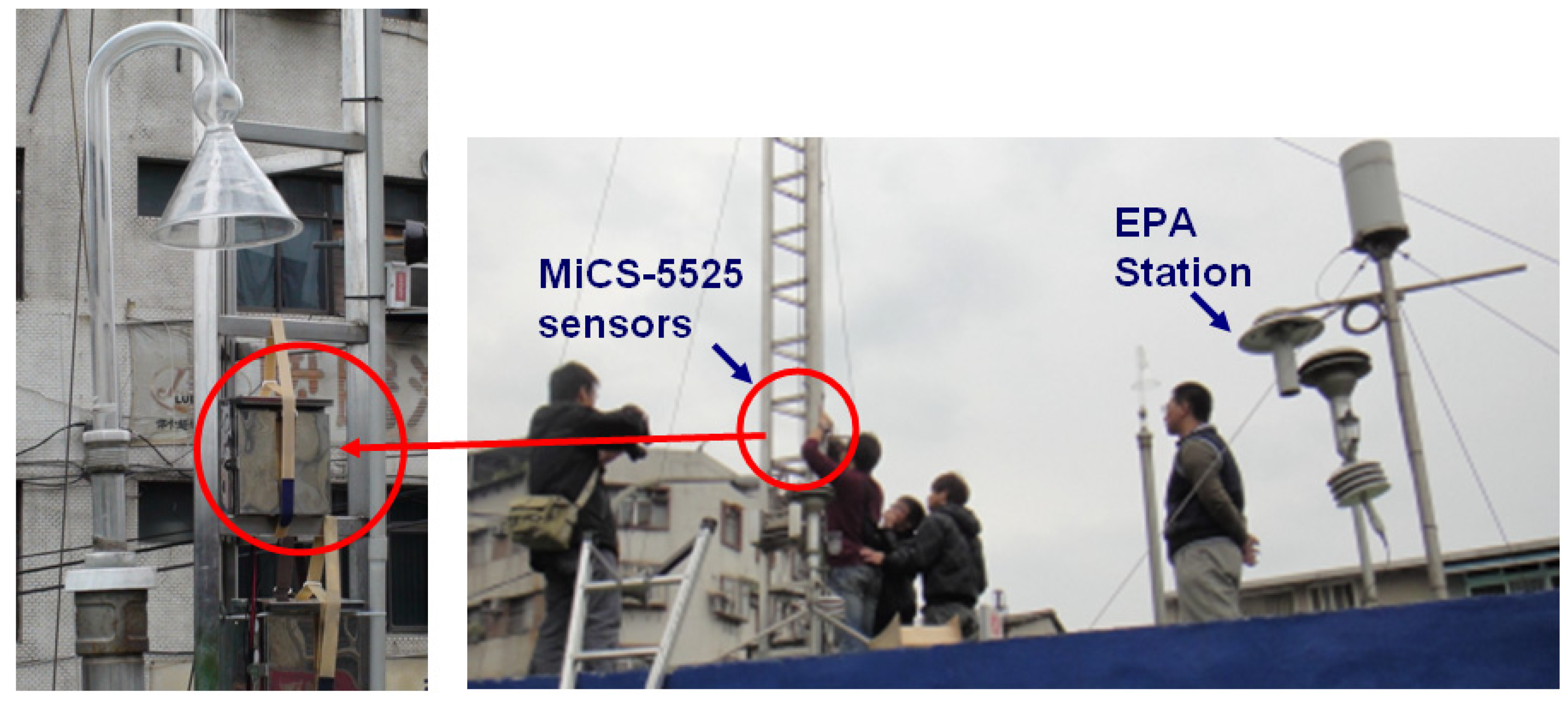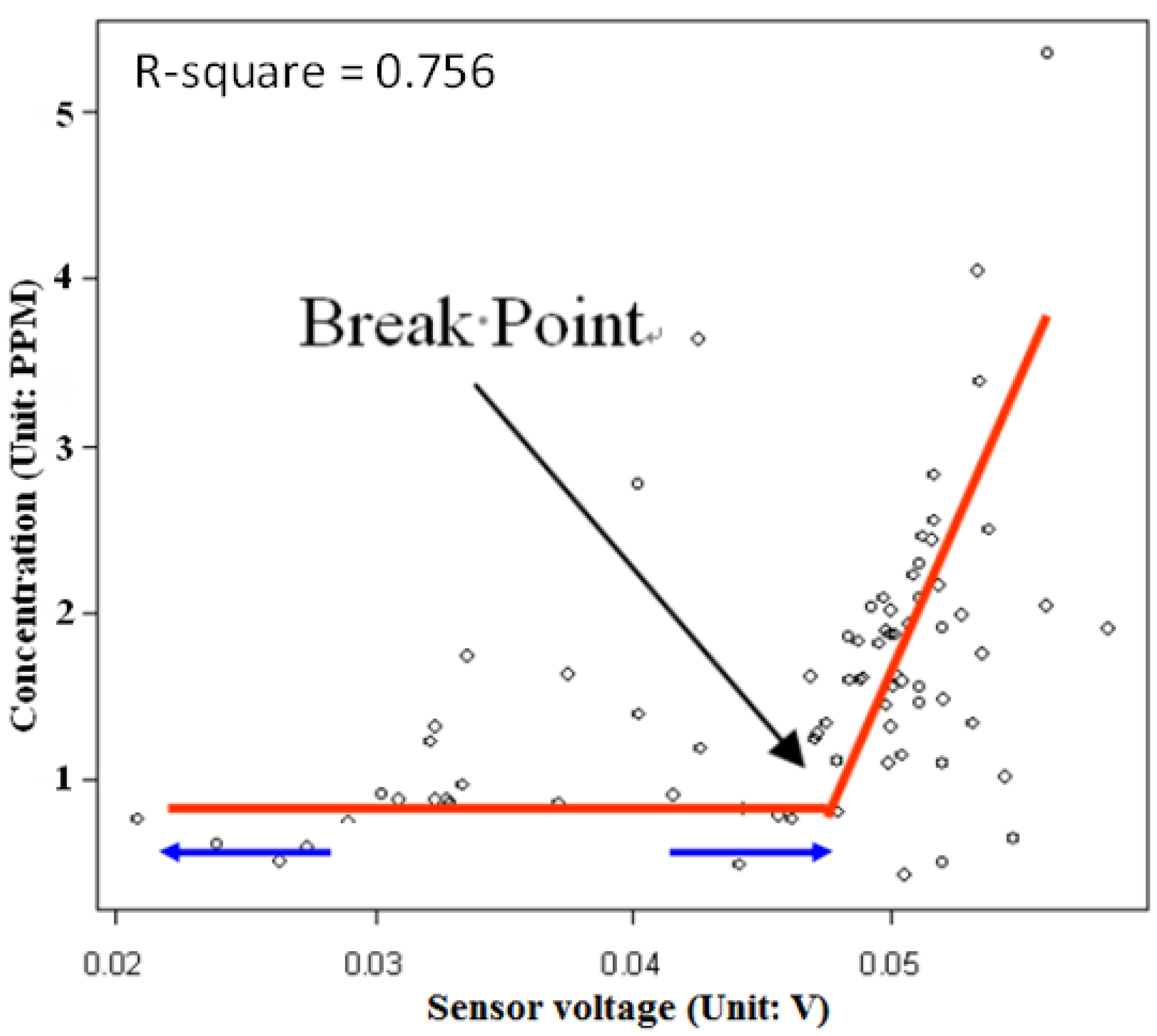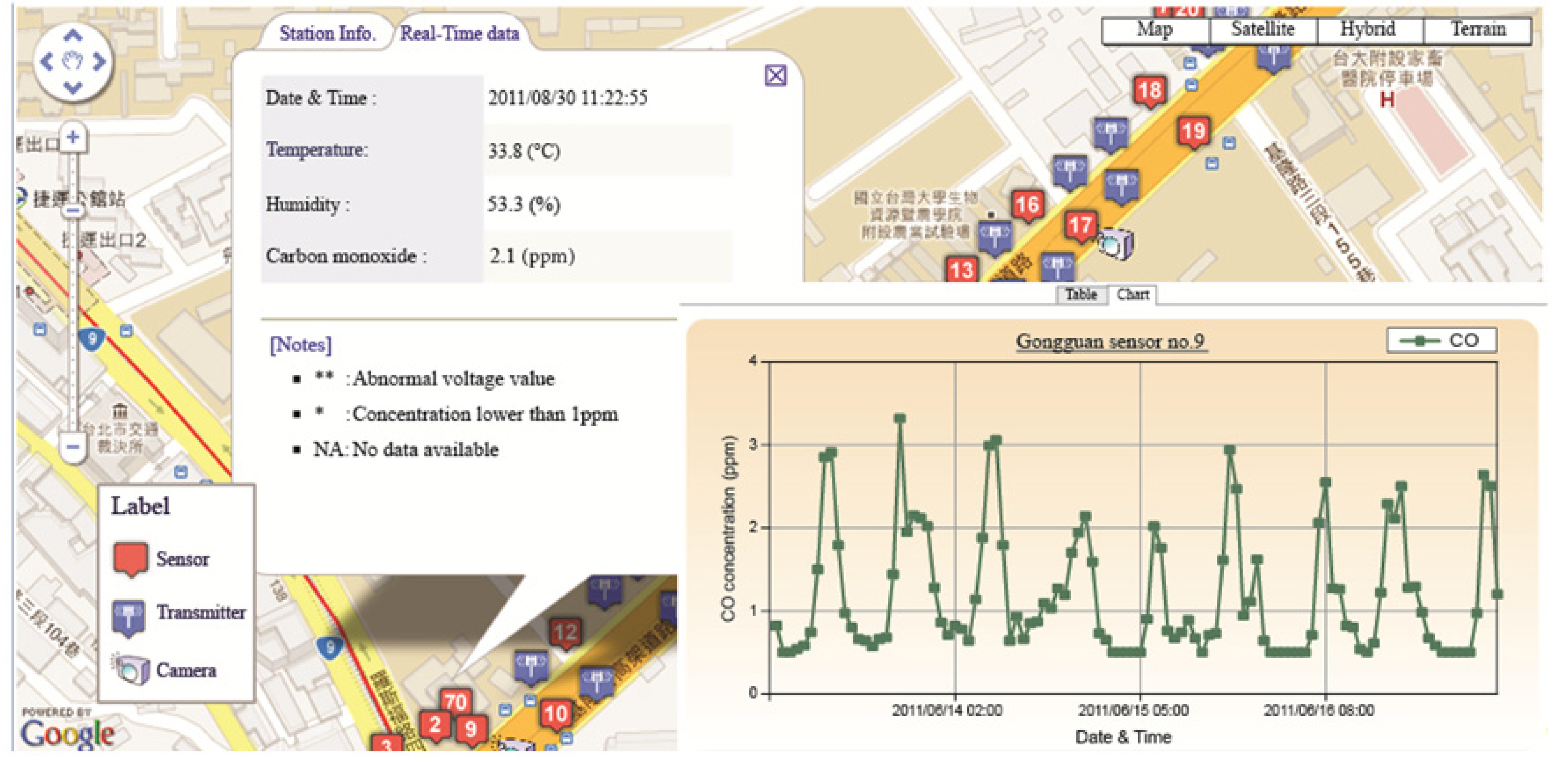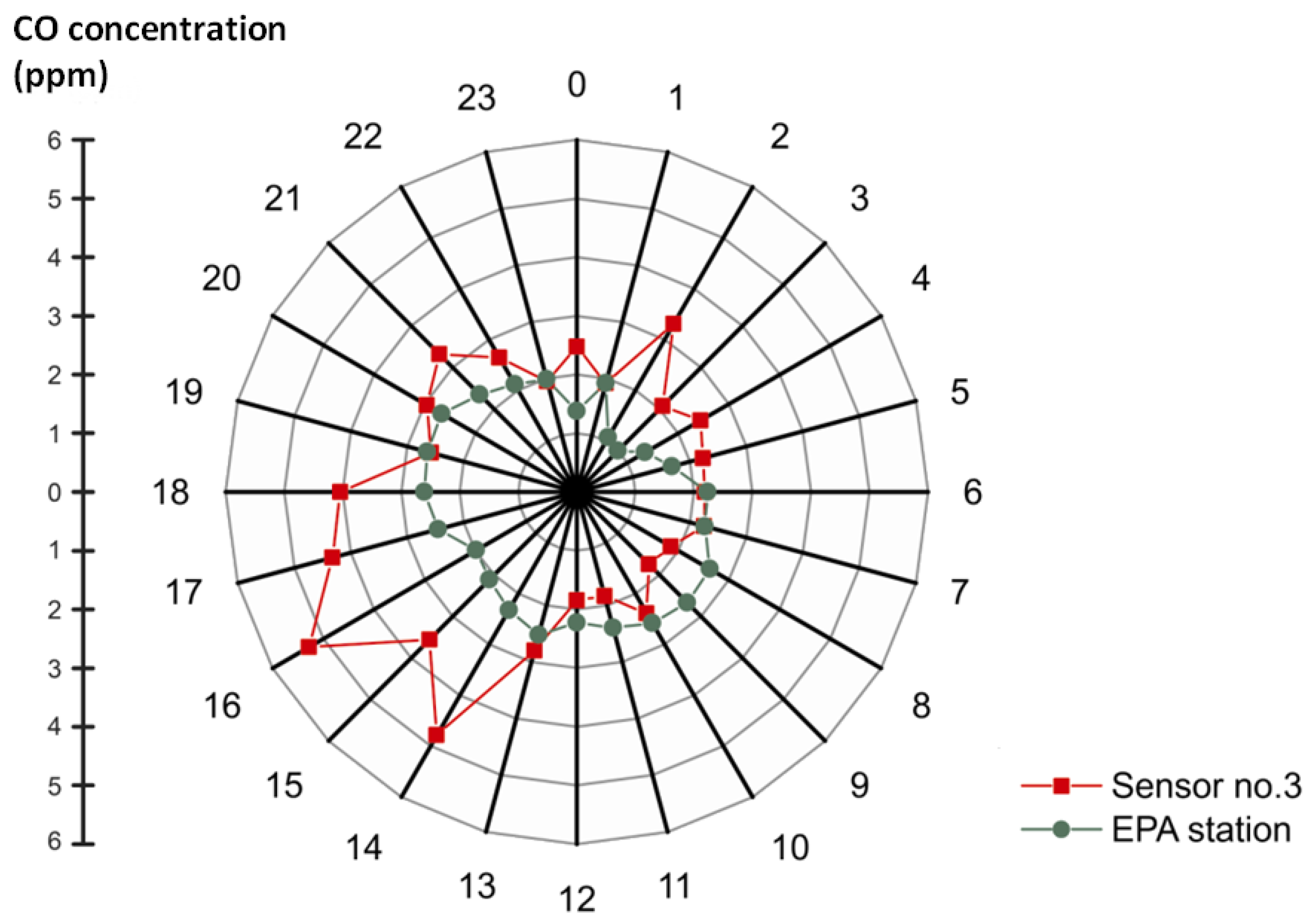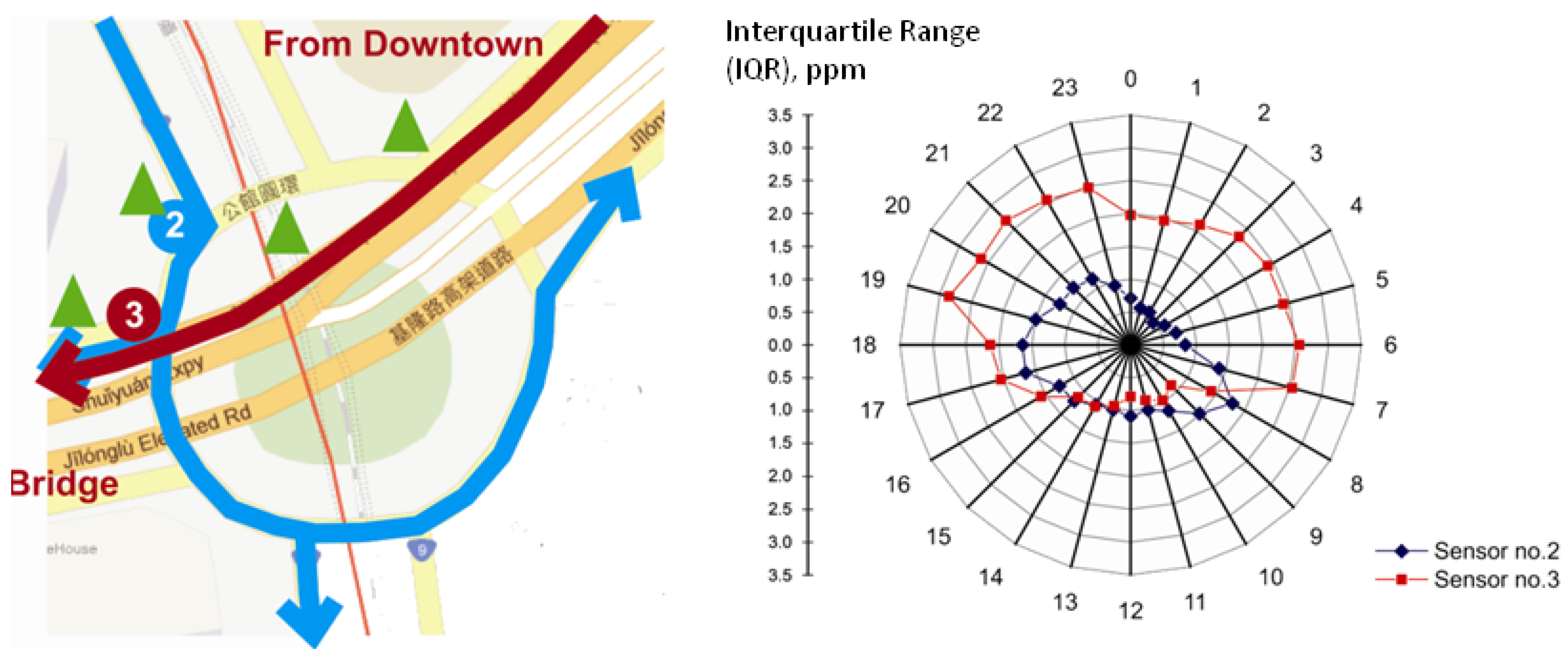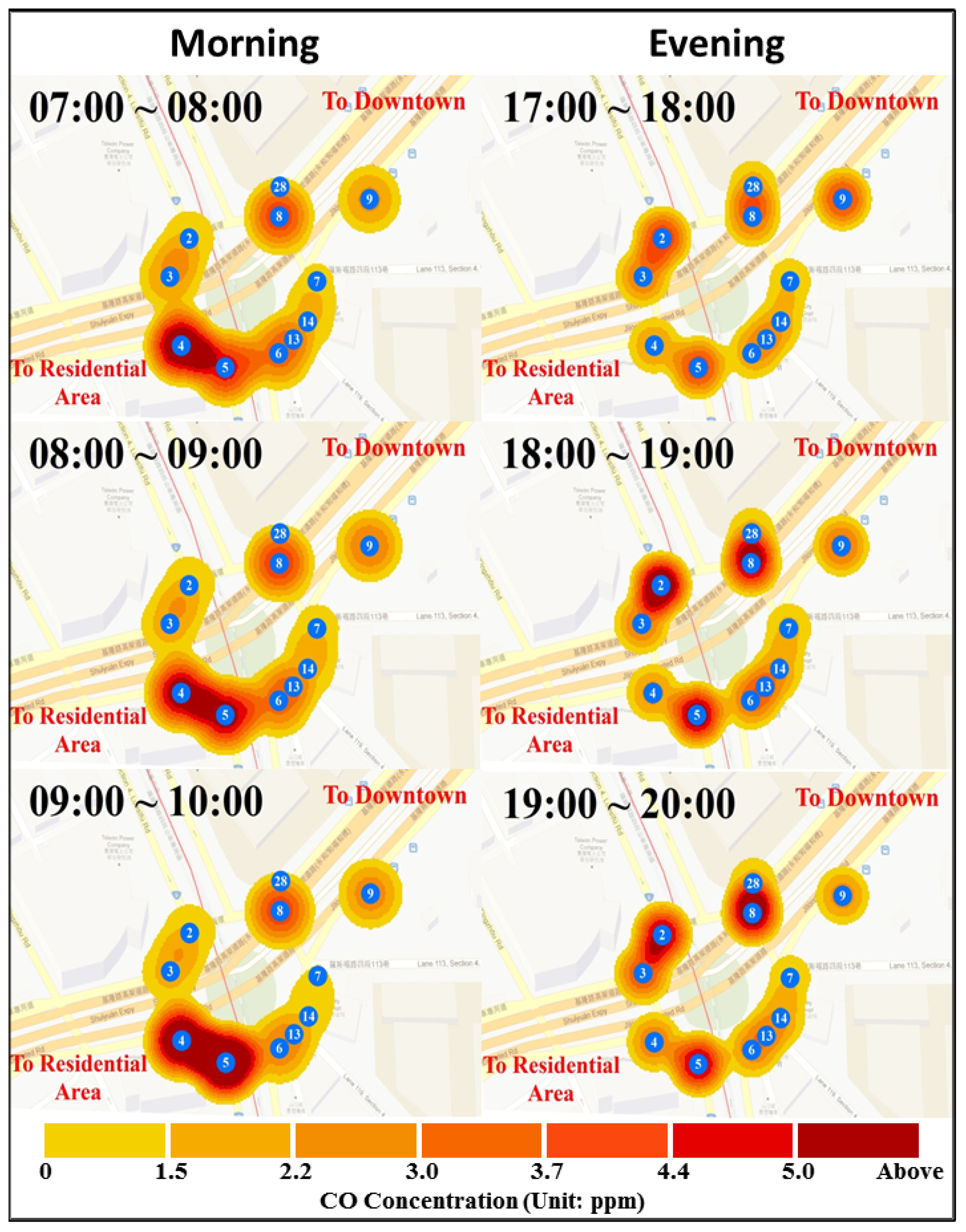1. Introduction
A well-established air quality monitoring system can enhance our understanding of the quality of life of the built environment. Empirical relationships between air pollutants and human health can be further discovered by combining the data of air quality and health outcomes [
1]. Early warning thresholds and environmental exposure health risks can be assessed using these empirical relationships. Therefore, many studies on air quality monitoring employ precise but expensive instruments to measure variations of air pollution on a large scale, such as over a city or even a county [
2,
3]. Most of the data of these studies were from government or academic institutes that established limited monitoring stations in a large-scale region to collect overall air pollutant conditions. For instance, the Environmental Protection Administration (EPA) of Taiwan deployed thirteen stations to monitor the air quality of Taipei City over an area of 272 km
2. In other words, each sensor in a station was responsible for monitoring almost 2,600 football fields with a total size of 20 km
2. The fine-scale geographic heterogeneity of air quality cannot be identified simply by measuring the overall patterns of a large-scale region. Therefore, traditional approaches limit the possibility of exploring the fine-scale spatial-temporal variations of air pollutants in the street-level environment and exposure to air pollution during traffic congestion.
Establishing a street-level monitoring system of air quality can assist in exploring fine-scale relationships between air pollutants and human activities. The sensors of a street-level monitoring system can capture fine-scale spatial-temporal variations of air quality. The information can help pubic administrators gain a more realistic picture of quality of life. In recent years, with the rapid growth of the manufacturing process in semi-conductor technology, such as smaller chip sizes and new sensing materials, lower-power consumption and better measurement accuracy can be achieved simultaneously [
4,
5]. It is now possible to deploy an effective wireless sensor network (WSN) in urban settings for studies on environmental monitoring [
6].
A WSN consists of spatially distributed sensors to monitor environmental conditions, such as temperature, noise and air pollution. Sensors in a WSN cooperatively pass their data over the wireless network to the main database. The growing body of literature focuses on the following topics. An optimized method to employ the fewest sensors to monitor a study area while obtaining accurate results has been studied by Al Hasan
et al. [
7]. Several authors have studied sensor technologies with lower power consumption to extend WSN’s application to transportation and environmental management fields [
8,
9,
10,
11]. Most studies on wireless sensor networks have focused on technical aspects, such as network design or data protocols [
12,
13]. Several studies have applied WSNs to environmental monitoring focused on the dynamics of indoor air pollutants. Green
et al. explored the
spatial-temporal variation of temperature and oxygen concentrations inside silage stacks [
14]. Aida deployed micro-sensors to form a smart office [
15]. Murty and his colleagues designed a sensor network to detect a sodium leak in a nuclear power plant [
16]. Applications in the outdoor environment have focused on monitoring agricultural settings such as crops [
17,
18] or aquaculture, such as sea cucumbers [
19].
The exposure risk to humans in outdoor environments is also an important issue. Jung
et al. designed an air pollution monitoring system using a geo-sensor network that involves a context model and a flexible data acquisition policy to form a guideline to save limited batteries because it reduces the amount of data transmitted [
20]. Khedo
et al. also planted numerous sensors to form a wireless sensor network air pollution monitoring system (WAPMS) in Reduit, Mauritius, to estimate the air quality index (AQI) of ozone (O
3), fine particulate matter, nitrogen dioxide (NO
2), carbon monoxide (CO), sulfur dioxide (SO
2) and total reduced sulfur compounds over the whole island [
21]. The study focused on the algorithm used to reduce the amount of data to be transmitted to save energy but not the possibilities of the monitoring results. Ma
et al. presented an air pollution monitoring and mining system based on a wireless sensor network and grid computing [
6]. A low-cost sensor network to collect real-time large-scale data from road traffic emissions was established to monitor air pollutants, such as benzene (C
6H
6), NO
2 and SO
2 in the built environment. The study considered road networks and traffic flow but only focused on the networking performance. Resch
et al. proposed the concept of “Live Geography”, which means using communication technology of geo-sensors to monitor real-time dynamics of environmental and social phenomena in geographical spaces [
22]. They used CitySense sensor network to build the mobile sensing environment in Cambridge and the city of Copenhagen. The study developed an interoperable open standards based infrastructure for providing air quality data. It also allows users to assess real-time environmental conditions.
Great advances in system frameworks, infrastructures and hardware of sensor network have been achieved in previous studies; however, research on exploring and comparing the street-level spatial-temporal patterns of air quality using wireless geo-sensors is still limited. Monitoring the variations of street-level air pollution can reflect short-term high concentrations of traffic-related air pollutants, including sulfur oxides, ozone, carbon oxides and suspended particles [
23]. CO is emitted by incomplete combustion in automobile engines [
24,
25]. Hence, a rising CO concentration can reflect daily heavy traffic periods and localized traffic areas. Therefore, the purpose of this study is to propose a pilot framework for a WSN-based environmental monitoring system of air pollution to estimate the exposure risk to humans. Because carbon monoxide (CO) is the major traffic pollutant from automobiles, the system further measures real-time fluctuations and analyzes street-level spatial-temporal changes of CO for urban environmental management policy.
3. Results and Discussion
3.1. Mean of Hourly Concentrations
We compared the differences of the hourly CO concentrations from the WSN-based sensor with the EPA monitoring station in similar urban settings.
Figure 7 depicts the hourly average CO concentration from July to September 2010 at sensor No. 3, which was located along an arterial (Keelung Road), and the distance to the nearest traffic sign was approximately 15 m. Four carbon monoxide (CO) concentration peaks were distributed throughout the day: (a) the peak at 2:00 pm, with an average concentration of 4.52 ppm, was due to lunch traffic during mid-day; (b) the highest peak was from 5:00 pm to 7:00 pm, with an average concentration of 5.3 ppm, due to congested traffic related to the off-duty time; (c) the peak at approximately 9:00 pm, with an average concentration of 3.26 ppm, was produced by the traffic flows of the service sectors getting off work; and (d) the night-shift workers caused the first peak in the day at approximately 2:00 am, with an average concentration of 3.50 ppm.On the other hand, the data from the EPA monitoring station where located at an intersection nearby the sensor No. 3. The CO concentration ranges from 1.0 to 2.7 ppm. The temporal fluctuation shows a smoother pattern compared with the monitoring result of WSN but still captures the significant differences of air quality between rush-hour and regular traffic over different time of a diurnal cycle (as shown in
Figure 7). The location of the EPA station is at the rooftop of a 4-meter-high building while the sensor from WSN is from a height of 1.5 m on lampposts and traffic signs. Therefore, it may be the reason that data from WSN shows more temporal fluctuations in a street-level environment and can capture more detailed ground information and risk of human exposure to traffic-related air pollution than an EPA station.
Figure 7.
Comparisons of hourly average CO concentration between Sensor No.3 and the EPA station over different time of a day from July to September 2010.
Figure 7.
Comparisons of hourly average CO concentration between Sensor No.3 and the EPA station over different time of a day from July to September 2010.
3.2. Street-Level Variations of Hourly Concentrations
The hourly means show that the WSN captured detailed temporal dynamics. We could go further to explore the data variations of the different sensors to understand the traffic patterns in different locations. As shown in
Figure 8, sensors No. 3 and No. 2 are selected to symbolize the difference of patterns between morning and evening. Sensor No. 3 is selected to represent a location that is affected by the difference of traffic flows on weekdays and weekends. Sensor No. 2 reflects a location that always accumulates high traffic volume from downtown to the residential areas. The difference between sensor No. 3 and No. 2 is that sensor No. 2 will not be influenced by the difference between weekdays and weekends. The arterial not only connects downtown to the satellite cities but also the southern part of the city. Traffic flows from downtown converge on the arterial and divert to roads R
a, R
b and R
c every day. Therefore, the difference between weekdays and weekends only has a slight effect on sensor No. 2. The arterial where sensor No. 3 is located only address the traffic flows from downtown to the satellite cities by bridge. Hence, the traffic flows will present a clear difference between weekdays and weekends. We select sensors No. 2 and No. 3 to discuss the effect of weekends.
Figure 8.
The hourly interquartile range (IQR) of CO concentrations of the sensor No. 2 and No. 3 at 24 hours a day from July to September 2010 (right panel). Sensor No. 3 represents a location affected by the difference of traffic flows on weekdays and weekends, but sensor No. 2 reflects a location that always accumulates high traffic volume from downtown to the residential areas (left panel). The traffic flows from downtown (blue lines) converge on the arterial and are diverted to different roads. The difference between weekdays and weekends only has a slight effect on sensor No. 2. The greater IQR of sensor No. 3 could be explained by the traffic flow (red line) only appearing during weekdays.
Figure 8.
The hourly interquartile range (IQR) of CO concentrations of the sensor No. 2 and No. 3 at 24 hours a day from July to September 2010 (right panel). Sensor No. 3 represents a location affected by the difference of traffic flows on weekdays and weekends, but sensor No. 2 reflects a location that always accumulates high traffic volume from downtown to the residential areas (left panel). The traffic flows from downtown (blue lines) converge on the arterial and are diverted to different roads. The difference between weekdays and weekends only has a slight effect on sensor No. 2. The greater IQR of sensor No. 3 could be explained by the traffic flow (red line) only appearing during weekdays.
Interquartile range (IQR) of hourly data in this study, the range between Q
1 and Q
3, is used as the indicator for measuring the variations of the hourly CO concentrations of the sensors.
Figure 8 depicts the hourly IQR of CO concentrations of the sensors from July to September 2010. A higher IQR in some hours indicates higher variations of concentrations in that hour of the study period. Being located near an arterial and between two traffic signs, the IQR of sensor No. 3 peaks at rush hour and diminishes during midday. This sensor shows a nearly triple IQR during rush hour than during midday. During the 6:00 am to 8:00 am rush hour, the CO concentration ranges from 1.00 to 3.35 ppm (IQR = 2.16). During 9:00 am to 2:00 pm, the CO concentration of sensor No. 2 ranges from 1.00 to 2.44 ppm (Average IQR = 1.02). It is higher than sensor No. 3 at 1 ppm but is lower than sensor No. 3 during rush hour. Sensor No. 2 presents two peaks during rush hour (8:00 am to 10:00 am and 6:00 pm to 8:00 pm) of approximately 1.50 to 1.70 ppm. However, the peaks of sensor No. 2 are still lower than those of sensor No. 3 at the same time.
Being only 60 m from sensor No. 3, the possible reason for the IQR difference may be its location. Located near a bus stop and just under a traffic sign, the arterial near sensor No. 2 is the only road that accumulates traffic flows from downtown, and traffic flows will be dispersed and diverted to satellite cities or residential areas south of the city under the traffic circle. As stated above, the traffic flows would not have a significant fluctuation between weekdays and weekends. Therefore, a smaller variance is recorded during midday. The greater IQR of sensor No. 3 could be explained by the different traffic patterns between weekdays and weekends. Due to the connection between downtown and the satellite cities, traffic congestion occurs due to commuting in the morning and evening on weekdays. Traffic congestion will increase the possibility of the interruption of automobiles by traffic signs. Therefore, the emission of CO is also increased by incomplete combustion. During the weekend, the traffic flow decreases to a lower level due to most of the labor force resting at home or taking trips outdoors. The high concentration during weekdays and the low readings from weekends worked together to produce variations of peaks in the timing of getting on and off work. However, the similar traffic flows at midday between weekdays and weekends resulted in lower variations at sensor No. 3.
There is a relatively higher IQR during midnight (11:00 pm to 5:00 am) at sensor No. 3. This sensor is located near the bridge connecting downtown and the satellite cities. The source of traffic flows consists not only of commuter vehicles but also freight vehicles. Freight vehicles such as trucks could tend to pass the bridge at midnight during weekdays to avoid traffic congestion, causing sensor No. 3 to have a higher IQR during midnight. Therefore, the difference of variations in hourly concentrations between sensor No. 2 and sensor No. 3 could reflect the difference of local environments subject to human activities.
3.3. Mapping Spatial-Temporal Variations of Hourly Concentrations
The above discussions have shown that the CO concentration not only undulates with human activities but also presents variations of the traffic pattern in the micro-scale environment. It is proven that the WSN has the ability to capture detailed street-level fluctuations more effectively than existing approaches. We can go further to organize a spatial-temporal visualization, as shown in
Figure 9, which compares the different concentration patterns between morning and evening. The congestion caused by morning/evening traffic flows from was selected as the study periods. The left side of
Figure 9 shows the dynamics of the CO concentration from 7:00 am to 10:00 am, and the right side shows the dynamics from 6:00 pm to 8:00 pm.
In the morning, all sensors maintain low readings except sensor No. 4, which shows a CO concentration above 5 ppm from 7:00 am to 8:00 am. The concentration rises in sensor No. 5 progressively from 8:00 am to 9:00 am. There is only slight growth in sensor No. 9. The pattern of 9:00 am to 10:00 am shows a hotspot (above 5 ppm) in the CO concentration around sensors No. 4 and No. 5. In the evening, it seems there is a uniform distribution of CO concentrations around the circle during 6:00 pm. However, the concentration gradually grows in sensors No. 2 and No. 8 from 6:00 pm to 7:00 pm up to 5 ppm. The distribution maintains a similar pattern throughout 8 pm.
There is also a clear pattern that the CO concentration is overall more intensive in morning than evening. This result could be related to the special industrial culture within Asian countries such as Japan, Korea and Taiwan [
29]. One of possible reasons could be that a salaried employee may clock in at approximately 8:00 am to 9:00 am, but they could not follow the same rule when getting off. Usually, a salaried employee can only leave the company after finishing their work. The traffic flows could be more disperse during evening than morning, therefore producing a higher and longer-lasting CO concentration from 7:00 am to 9:00 am.
Figure 9.
Street-level spatial-temporal variations around the circle: a clear on/off-peak traffic pattern is captured by WSN. In the morning, many vehicles drive from residential to downtown areas for work. This congestion induces a high concentration of air pollutants near a traffic signal. In the evening, the traffic flow to residential areas increases and it results in high concentrations at the contrast side.
Figure 9.
Street-level spatial-temporal variations around the circle: a clear on/off-peak traffic pattern is captured by WSN. In the morning, many vehicles drive from residential to downtown areas for work. This congestion induces a high concentration of air pollutants near a traffic signal. In the evening, the traffic flow to residential areas increases and it results in high concentrations at the contrast side.
Previous studies have shown a positive correlation between traffic flows and the concentration of air pollutants such as CO [
30,
31,
32]. The regularity of traffic flows will cause the CO concentration fluctuations. Certain regular cycles could be observed for all individuals 24 h a day. A person engages in a series of routine activities, such as sleeping, commuting and working following. From this perspective, because traffic flows is a representation of human activities, it seems that regularity plays an important role in the fluctuation of the CO concentration. Moreover, exposure to air pollutants affects public health in a significant way, especially in the street-level environment [
33,
34]. Heavy traffic contributes to most of the air pollutants on a road network. Exhaust containing CO is emitted when a vehicle engine transitions from idling to operation mode. Vehicles will have a higher possibility of stopping multiple times due to traffic signs. Therefore, serious traffic congestion exacerbates CO emission repeatedly due to a slower speed during heavy traffic periods. In our study, 7 of 11 (63.6%) sensors were distributed around a circle, revealing a pattern similar to that in
Figure 7, which implies that the sensors located near the bus stop and pedestrian crossing monitored a similar pattern as sensor No. 3. People standing near the pedestrian crossing or bus stop around the circle will be exposed to higher concentrations of CO during rush hour. Therefore, evaluating the potential of wireless sensor networks to monitor the patterns would enhance our understanding of human exposure to air pollutants under the street-level environment. Furthermore, the dynamics of air pollutants from the traffic is a continuous space-time process. In further studies on space-time diffusion of air pollutants, not only the spatial-temporal variations of CO concentration can be monitored and analyzed separately, but sensor data from WSN-based framework would be beneficial to implement advanced spatial-temporal models for predicting the trends of high CO concentration corresponding to traffic conditions.
Although there are still some research limitations, there are some important implications from this study. First, in our analysis, we did not use a CO standard gas to calibrate the CO concentrations of the sensor. Instead, we calibrated the sensor by using real-time data from EPA station at the same time. The reason is that the micro-environmental conditions could have curtain effects on variations of CO readings. Therefore, before the deployment, we calibrated the CO concentrations of each wireless sensor by using data from the EPA station at the same time. Second, due to the accuracy and performance of the low-cost wireless sensors are not as good as the readings from EPA stations. Therefore, in this study the WSN-based framework is not proposed to replace the existing official monitoring systems. The purpose of the WSN-based monitoring framework plays a different role from the EPA stations. A wireless sensor may not provide high accuracy on measuring CO concentrations, but deploying large amount of spatially distributed sensors could provide significant spatial-temporal patterns in micro-scale environment [
20,
21]. The WSN-based framework could detect possible exceptional conditions and provide critical early warning signals for environment monitoring in time and space. Third, according to the Air Quality Standards by EPA of Taiwan and National Ambient Air Quality Standards (NAAQS) by the US EPA, the one-hour averaged CO concentration exceeding 35 ppm is considered harmful to public health and the environment. In our study the results showed that traffic congestion could cause an hourly average concentration of 5.3 ppm, which is lower than the air quality standard. However, the standard of CO concentration may not be appropriate as the early-warning threshold for street-level traffic pollutants, because human exposures to heavy traffic could be daily routine and long-term continually and chronically accumulated in urban areas [
25]. Therefore, accumulated effects of traffic congestion should be further considered when EPA set the early-warning thresholds of CO concentration for traffic pollutants.

